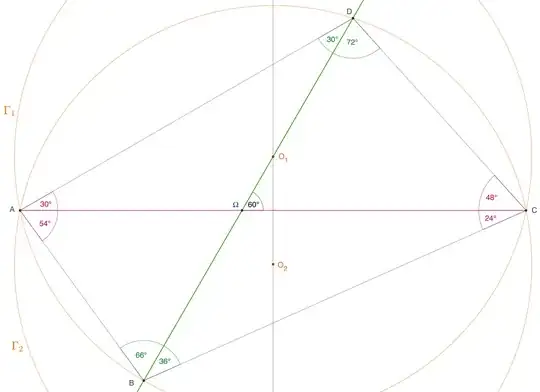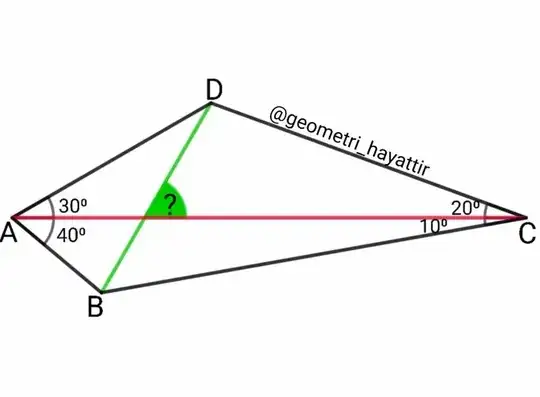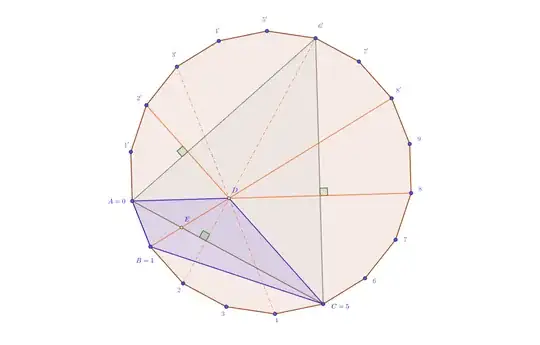All following angles are measured in degrees.
Let $r>0$.
Construct two circles $\Gamma_1$ and $\Gamma_2$ with respective centers $O_1$, $O_2$ and same radius $r$.
Taking suitable coordinates we may assume that $O_1(t\mathbin;0)$ and $O_2(-t\mathbin;0)$, with $t\in\mathopen]0\mathbin;r\mathclose[$, so that the circles meet at two distinct points $A(-s\mathbin;0)$ and $C(s\mathbin;0)$.
By Pythagoras' theorem $r^2=s^2+t^2$.
From now on we'll even take $0<t<r\frac{\sqrt3}2$ (equivalently $\frac r2<s<r$); this implies that $s>\frac{t}{\sqrt3}\cdot$
Construct a straight line $\Delta$ passing through $O_1$ and making an angle of $60^\circ$ with the line $(AC)$.
This line cuts $\Gamma_1$ at $B$, interior to $\Gamma_2$, and cuts $\Gamma_2$ at $D$, interior to $\Gamma_1$ (which is made possible thanks to the restriction on $t$).
We also name $\Omega$ the intersection between $\Delta$ and $[A\mathbin,C]$.
Taking $y=x\sqrt3+t$ as cartesian equation for $\Delta$, several coordinates can be deduced, as shown on the following picture.

Also, some interesting relations between angles can be computed.
• $\bbox[black,6px]{\color{white}{\alpha=\varphi_2}}$.
We have $\overrightarrow{D\Omega}\mathord:
\Big(t\frac{\sqrt3}6-\frac s2\mathbin;\frac t2-s\frac{\sqrt3}2\Big)$,
thus $D\Omega=\frac{t^2}3+s^2-2ts\frac{\sqrt3}3
=\Big(s-\frac t{\sqrt3}\Big)^2$;
this gives $D\Omega=s-\frac t{\sqrt3}=A\Omega$ and proves that $A\Omega D$ is isosceles, with vertex $\Omega$, and that
$\alpha=\varphi_2=30^\circ$.
• $\bbox[black,6px]{\color{white}{\gamma=2\delta}}$.
We have $\overrightarrow{CD}\mathord:
\Big(-t\frac{\sqrt3}2-\frac s2\mathbin;-\frac t2+s\frac{\sqrt3}2\Big)$, which provides $CD=\sqrt{s^2+t^2}=r$.
We compute $\overrightarrow{CA}.\overrightarrow{CD}=s(s+t\sqrt3)$.
Then $\cos\gamma=\frac{\overrightarrow{CA}.\overrightarrow{CD}}{CA.CD}
=\frac{s+t\sqrt3}{2r}\cdot$
Then we can compute $\cos\delta=\frac{r+2s}{2\sqrt{r(2r+s-t\sqrt3)}}$ and deduce from it that
$$\begin{array}{rcl}
2\cos^2\delta-1&=&\frac{(r+2s)^2-2r(2r+s-t\sqrt3)}{2r(2r+s-t\sqrt3)}\\[3pt]
&\vdots&\\
&=&\frac{s+t\sqrt3}{2r}
=\cos\gamma.
\end{array}$$
That is: $\cos(2\delta)=\cos\gamma$.
Using the fact that the sum of interior angles of a triangle is $180$, we deduce:
$\vartheta_2=120-\gamma=120-2\delta=2(60-\delta)=2\vartheta_1$.
• $\bbox[black,6px]{\color{white}{\vartheta_1=90-\beta}}$.
$\cos\vartheta_1=\frac{\overrightarrow{BC}.\overrightarrow{BD}}{BC.BD}$ can be computed as above.
We use $BD=r+s-t\sqrt3$, $BC=\sqrt{r(2r+s-t\sqrt3)}$,
$\overrightarrow{BC}.\overrightarrow{BD}
=\frac12(r+s-t\sqrt3)(2r+s-t\sqrt3)$
and obtain $\cos\vartheta_1=\frac12\sqrt{\frac{2r+s-t\sqrt3}{r}}\cdot$
Similarly (details omitted) we get $\cos\beta
=\frac{s-\frac r2}{\sqrt{r(2r+s-t\sqrt3)}}\cdot$
Finally we obtain $\cos^2\vartheta_1+\cos^2\beta=1$.
This shows that $\vartheta_1+\beta=90$.
• Back to the initial question.
Taking $t=r\cos50^\circ$, we get $\cos\gamma=\frac{s+t\sqrt3}{2r}
=\sin50^\circ\sin30^\circ+\cos50^\circ\cos30^\circ
=\cos20^\circ$.
This gives $\gamma=20^\circ$, $\delta=10^\circ$, then $\vartheta_2=100^\circ$, $\vartheta_1=50^\circ$ and $\beta=40^\circ$.
• Another instance with a different choice for $t$:
 • Comment.
Experimenting with Geogebra seems to indicate that, if one chooses another initial angle than $60^\circ$, then the relation $\beta+\vartheta_1=90$ stills holds…
• Comment.
Experimenting with Geogebra seems to indicate that, if one chooses another initial angle than $60^\circ$, then the relation $\beta+\vartheta_1=90$ stills holds…




